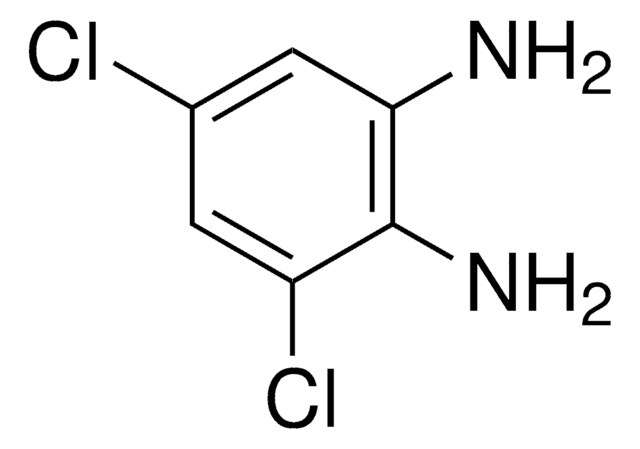108871
4-Chloro-o-phenylenediamine
97%
Synonym(s):
4-Chloro-1,2-diaminobenzene
Sign Into View Organizational & Contract Pricing
All Photos(2)
About This Item
Linear Formula:
ClC6H3(NH2)2
CAS Number:
Molecular Weight:
142.59
Beilstein:
508472
EC Number:
MDL number:
UNSPSC Code:
12162002
eCl@ss:
39030501
PubChem Substance ID:
NACRES:
NA.23
Recommended Products
Assay
97%
mp
70-73 °C (lit.)
SMILES string
Nc1ccc(Cl)cc1N
InChI
1S/C6H7ClN2/c7-4-1-2-5(8)6(9)3-4/h1-3H,8-9H2
InChI key
BXIXXXYDDJVHDL-UHFFFAOYSA-N
Looking for similar products? Visit Product Comparison Guide
Related Categories
Application
Undergoes cyclizations and cyclocondensations to form benzimidazoles.
Signal Word
Warning
Hazard Statements
Precautionary Statements
Hazard Classifications
Carc. 2 - Eye Irrit. 2 - Skin Irrit. 2 - STOT SE 3
Target Organs
Respiratory system
Storage Class Code
11 - Combustible Solids
WGK
WGK 3
Flash Point(F)
Not applicable
Flash Point(C)
Not applicable
Personal Protective Equipment
dust mask type N95 (US), Eyeshields, Gloves
Choose from one of the most recent versions:
Already Own This Product?
Find documentation for the products that you have recently purchased in the Document Library.
Customers Also Viewed
The Journal of Organic Chemistry, 58, 7016-7016 (1993)
L Soler-Niedziela et al.
Mutation research, 259(1), 43-48 (1991-01-01)
Three structurally related compounds, 4-chloro-o-phenylenediamine (COP), 4-nitro-o-phenylenediamine (NOP) and p-phenylenediamine dihydrochloride (PPD), are used in fur dyes, inks and hair coloring formulations. COP has been reported to be carcinogenic in both rats and mice. NOP and PPD are non-carcinogens, but
F Staedtler et al.
Mutation research, 430(1), 121-130 (1999-12-11)
The monocyclic aromatic amine 4-chloro-o-phenylenediamine (4-C-o-PDA), a known mutagen and mouse hepatocarcinogen, was tested for its in vivo mutagenic potential in the Big Blue transgenic mouse assay system. Genomic DNA was isolated from liver tissue of control and treated animals
Synthesis, 446-446 (1992)
4-Chloro-o-phenylenediamine.
Report on carcinogens : carcinogen profiles, 12, 101-102 (2011-08-19)
Our team of scientists has experience in all areas of research including Life Science, Material Science, Chemical Synthesis, Chromatography, Analytical and many others.
Contact Technical Service












